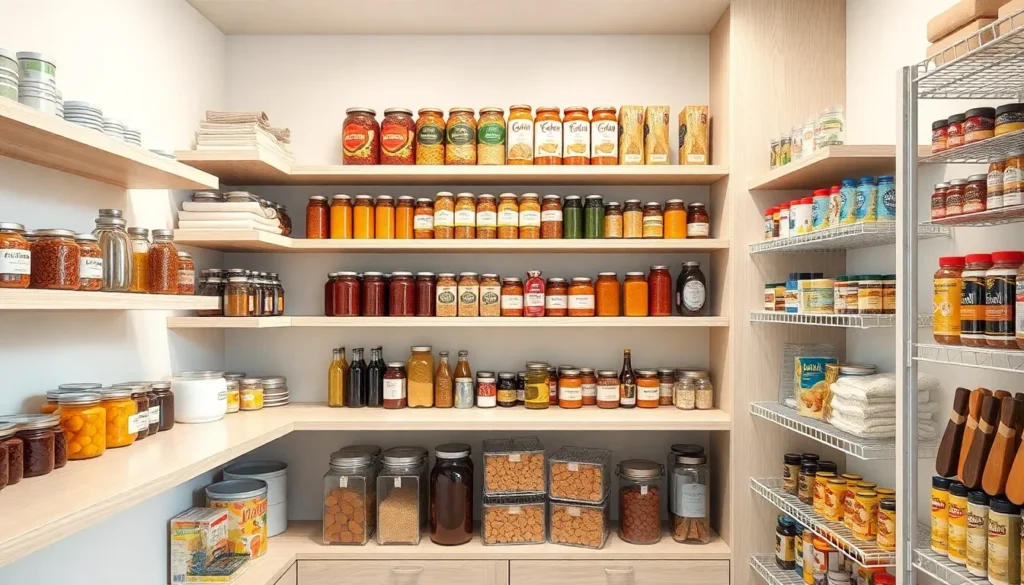A well-organized pantry transforms your kitchen from chaotic to calm, and it all starts with smart shelving answers. We’ve discovered that the right shelving system doesn’t just maximize storage space—it revolutionizes how efficiently you cook and meal prep every day.
Whether you’re dealing with a cramped cabinet or a spacious walk-in pantry, we’ll show you proven shelving strategies that professional organizers swear by. From adjustable wire racks to custom wood installations, these ideas work for every budget and skill level.
Ready to turn your pantry into a beautifully organized powerhouse? We’ve compiled the most effective shelving answers that’ll help you see everything at a peek, eliminate food waste, and make grocery shopping a breeze. Let’s jump into these game-changing pantry shelving ideas that’ll transform your storage space forever.
Floating Shelves for a Modern Minimalist Look
Floating shelves offer the perfect solution for creating clean lines and maximizing storage space in modern pantries. These wall-mounted wonders eliminate visual clutter while providing essential storage functionality.
Benefits of Wall-Mounted Floating Shelves
Space efficiency becomes your pantry’s greatest advantage with floating shelves that don’t require floor space or bulky brackets. We’ve found these shelves create up to 30% more usable storage area compared to traditional freestanding units.
Visual appeal transforms your pantry into a sleek, organized space that feels larger and more inviting. Floating shelves maintain clean sight lines throughout the room, making even small pantries appear spacious and well-designed.
Customizable height allows you to adjust shelf placement based on your exact storage needs. You can position shelves at optimal heights for cereal boxes, canned goods, or small appliances without wasting vertical space.
Easy cleaning becomes effortless since there are no floor-based supports or hard-to-reach corners where dust accumulates. We simply wipe down each shelf surface and the wall beneath stays accessible for thorough cleaning.
Best Materials for Floating Pantry Shelves
Solid wood provides the strongest foundation for heavy pantry items like large containers, bulk goods, and small appliances. Oak, maple, and pine offer excellent weight capacity ranging from 50-80 pounds per shelf when properly installed.
Metal brackets with wood tops combine industrial strength with aesthetic appeal, supporting weights up to 100 pounds per shelf. Stainless steel or powder-coated steel brackets resist moisture and temperature changes common in pantry environments.
Thick plywood offers an affordable alternative that handles moderate loads of 30-50 pounds per shelf. We recommend 3/4-inch thick plywood with a smooth finish or laminate coating for easy maintenance and durability.
Glass shelves work beautifully for displaying attractive food containers and lightweight items up to 25 pounds per shelf. Tempered glass provides safety and creates an open, airy feeling that enhances your pantry’s modern aesthetic.
Installation Tips for Maximum Weight Support
Locate wall studs using a stud finder to ensure your floating shelves anchor into solid wood framing rather than just drywall. We mark stud locations with pencil before measuring shelf placement for the strongest possible installation.
Use appropriate fasteners based on your wall type and expected weight load. Heavy-duty wall anchors, toggle bolts, or wood screws into studs provide the necessary holding power for fully loaded pantry shelves.
Install brackets level using a spirit level to prevent items from sliding off and ensure even weight distribution across the shelf surface. We double-check measurements and use a laser level for multiple shelves to maintain perfect alignment.
Test weight capacity gradually by adding items slowly after installation to verify the shelf handles your intended load safely. Start with lighter items and progressively add heavier containers while monitoring for any sagging or movement.
Wire Shelving Systems for Maximum Visibility

Wire shelving transforms pantry organization by offering unobstructed views of your stored items. ClosetMaid’s ventilated wire systems lead the market with their superior visibility and airflow design.
Advantages of See-Through Wire Shelving
Cost effectiveness makes wire shelving an attractive option for budget conscious homeowners. These systems typically cost 40-60% less than solid shelving alternatives while delivering comparable functionality.
Durability comes from cold-drawn steel construction that provides enhanced tensile strength. Wire shelves can support substantial weight loads without bending or warping over time.
Customization options include various wire diameters and densities to match your exact storage needs. Thicker wires handle heavier items like canned goods while standard configurations work perfectly for lighter pantry staples.
Airflow circulation prevents moisture buildup that can damage stored food items. The open wire design allows air to move freely around products, maintaining freshness longer than enclosed storage systems.
Adjustable Height Wire Shelf Answers
Vertical adjustability lets you customize shelf spacing as your storage needs evolve. ClosetMaid’s ShelfTrack system provides both vertical and horizontal positioning options for maximum flexibility.
ADA compliance makes these systems suitable for users of all ages and abilities. The adjustable height feature accommodates wheelchair users and meets accessibility requirements for senior living facilities.
Quick reconfiguration takes just minutes without tools or permanent modifications. You can easily move shelves up or down to accommodate tall items like cereal boxes or large containers.
Growing storage needs become manageable when you can adjust shelf heights seasonally. Holiday baking supplies require different spacing than everyday pantry items.
Preventing Small Items From Falling Through
Close mesh design features 5/8 inch wire spacing compared to standard 1 inch openings. This tighter configuration prevents small items like spice packets and seasoning containers from slipping through gaps.
Secure storage keeps tiny items like individual tea bags and small condiment packets properly contained. The reduced spacing eliminates the frustration of lost items falling behind shelves.
Tilting prevention stops lightweight packages from shifting position and potentially falling. Items like envelope seasonings and small sauce packets stay securely in place.
Organization efficiency improves when small items remain visible and accessible. You’ll spend less time searching for misplaced items that might otherwise slip through larger wire openings.
Pull-Out Drawer Shelves for Easy Access
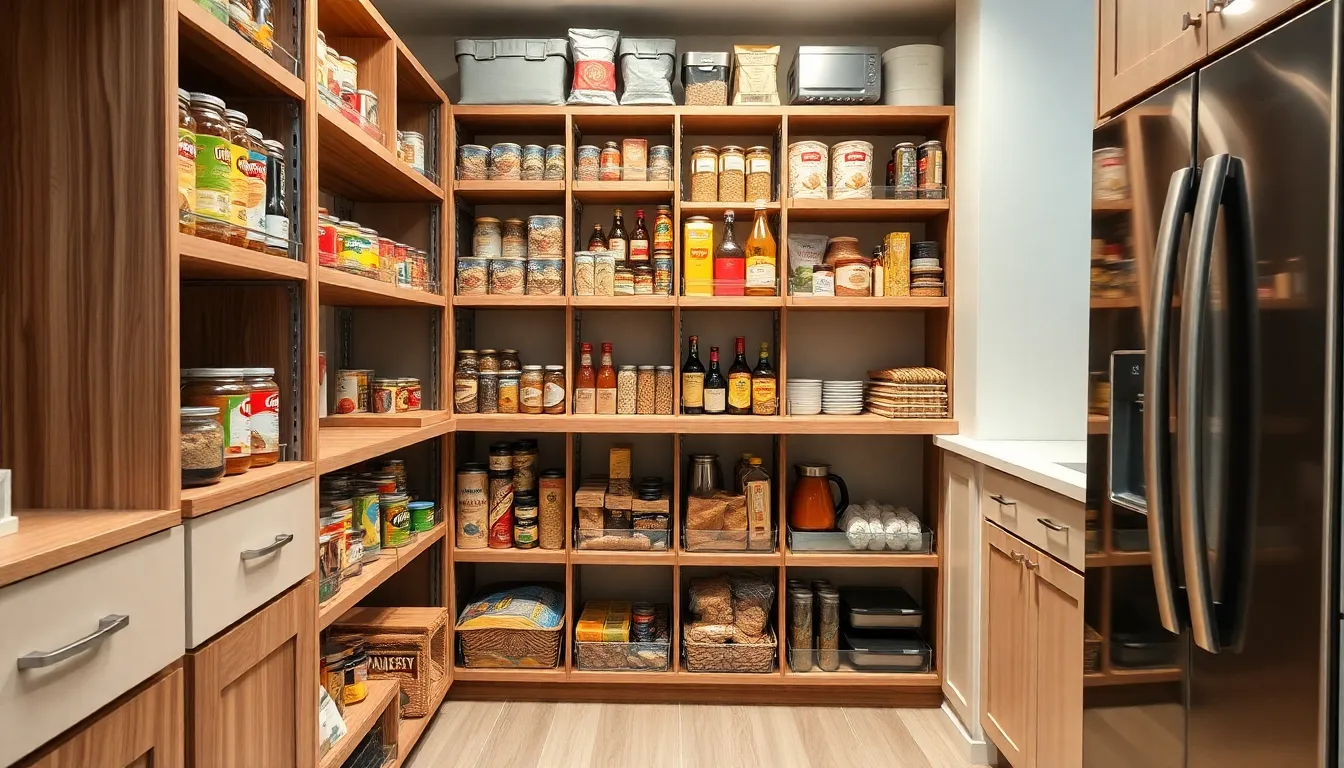
Pull-out drawer shelves transform deep pantry spaces by bringing items at the back within easy reach. These slide-out systems eliminate the frustrating need to remove everything in front just to access what you’re looking for behind.
Installing Sliding Drawer Mechanisms
Measuring your available space comes first when installing sliding drawer mechanisms in your pantry. We recommend selecting drawer slides that are rated for your intended load capacity before beginning the installation process.
Securing the hardware involves attaching sliding mechanisms to the sides or bottom of your pantry shelves using appropriate screws. Full-extension slides provide complete access to stored items, while soft-close options ensure quiet operation throughout your kitchen.
Adjustable mounting systems allow us to customize the installation to fit various pantry sizes and configurations. We can fine-tune the positioning to accommodate your exact storage needs and cabinet dimensions.
Ideal Items for Pull-Out Pantry Storage
Canned goods work exceptionally well in pull-out drawers because you can easily see and access every item without moving others around. Spices, oils, and baking ingredients also benefit from this accessible storage method.
Dry goods storage becomes more efficient when organized in pull-out systems, particularly for items like pasta, rice, and cereals. Small appliances that you use regularly can find a perfect home in these deeper drawer spaces.
Taller bottles and bags that typically create access challenges on fixed shelves work beautifully in pull-out storage. We suggest using clear bins or baskets inside the drawers to group similar items and maintain organization.
Weight Capacity Considerations for Drawer Shelves
Drawer slides and shelf materials must be rated to handle your intended load, including both food items and storage containers. Heavy-duty slides become essential when storing large quantities or particularly heavy pantry items.
Manufacturer specifications should always guide your weight limit decisions to prevent hardware failure or drawer jamming. Overloading these systems compromises both access and safety, potentially causing costly repairs.
Sturdy base materials work along with appropriate slide mechanisms to support your storage needs effectively. We recommend checking weight ratings before installation and distributing heavy items across multiple drawers when possible.
Corner Shelving Solutions to Maximize Space
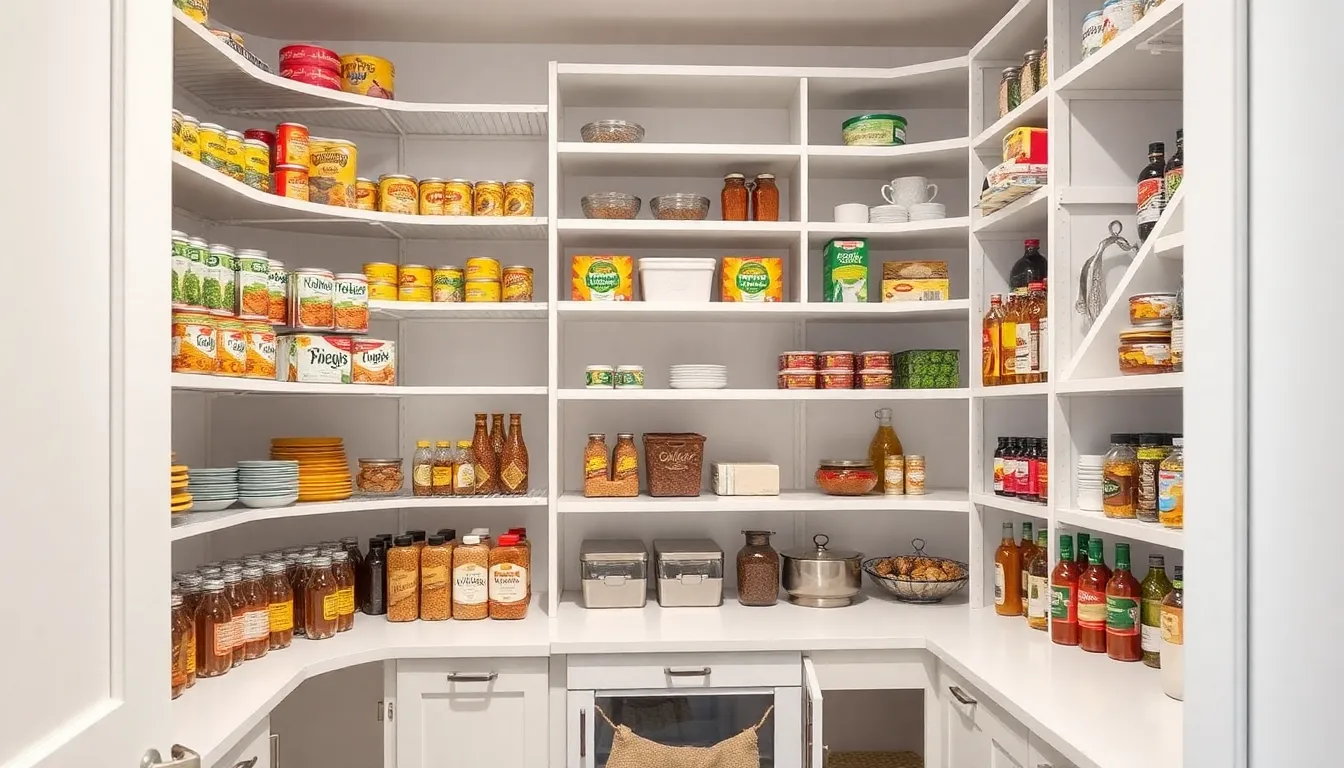
Corner spaces often become the most underutilized areas in our pantries, but they offer tremendous potential for increasing storage capacity. We can transform these awkward spaces into highly functional storage zones with the right shelving answers.
Lazy Susan Corner Shelf Systems
Lazy Susan systems revolutionize corner storage by bringing hard-to-reach items directly to us with a simple spin. These rotating trays mount inside corner cabinets or on existing shelves, eliminating the frustration of digging through deep corners to find what we need.
Installing these systems in deep corners makes stored items effortlessly accessible without moving everything at the front. We recommend choosing adjustable models that accommodate different container heights, from tall cereal boxes to short spice jars. Full-extension lazy Susans maximize the rotation radius, ensuring we can access items stored along the entire perimeter.
Dual-tier rotating systems double our corner storage capacity while maintaining easy access to both levels. Heavy-duty ball bearings ensure smooth rotation even when fully loaded with canned goods or small appliances.
Triangular Corner Shelf Designs
Triangular shelving fits precisely into corner angles, providing customized storage that matches the exact dimensions of our space. These specially shaped shelves eliminate wasted gaps that occur when using standard rectangular shelving in corner areas.
Open triangular shelves work perfectly for displaying frequently used items like spices, condiments, or grab-and-go snacks. We can choose from standalone units that require no installation or built-in options that create a seamless appearance with existing cabinetry.
Multiple triangular shelves create vertical storage towers in corners, maximizing our available square footage. Angled designs prevent items from sliding off while providing clear visibility of everything we’ve stored.
Making Dead Corner Space Functional
Pull-out drawers transform the most challenging corner spaces into accessible storage zones that we can fully use. These sliding systems bring corner contents completely out of the cabinet, making every item visible and reachable.
Sliding baskets work exceptionally well for lightweight items like pasta boxes, snack packages, or baking supplies. We can install multiple basket levels to create organized sections for different food categories.
Specialized corner inserts adapt to various cabinet configurations, turning formerly wasted space into effective storage areas. Wire rack systems provide ventilation while maximizing vertical space, perfect for storing produce or packaged goods that benefit from airflow.
Modular corner systems allow us to customize our storage configuration as our needs change over time. DIY corner shelving kits offer cost-effective answers that we can install ourselves with basic tools and hardware.
Adjustable Shelving for Flexible Storage Options
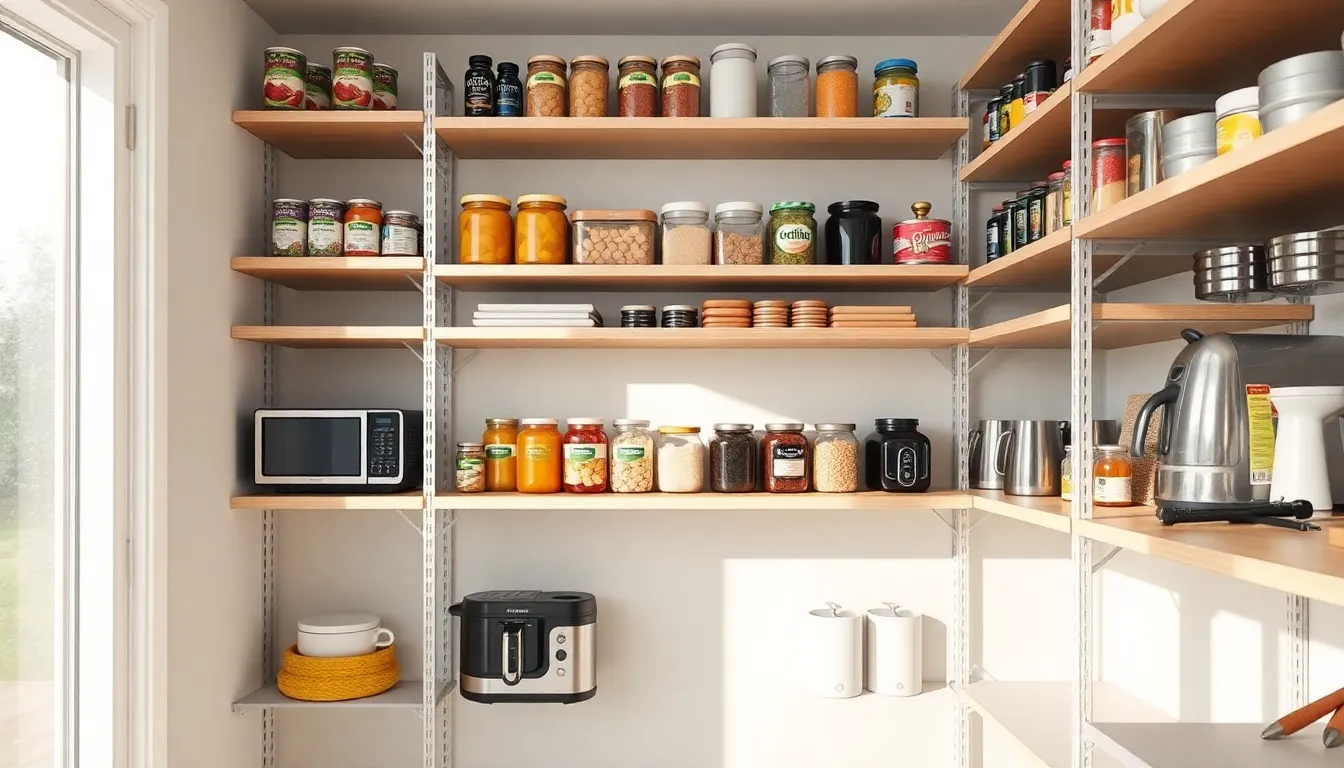
We’ve found that adjustable shelving systems offer the ultimate pantry storage solution by adapting to your changing needs over time. These versatile systems allow you to reconfigure shelf heights instantly, ensuring every inch of vertical space gets maximized.
Benefits of Customizable Shelf Heights
Enhanced space utilization becomes effortless when you can adjust shelves to fit items perfectly. We can maximize vertical space by positioning shelves closer together for canned goods or spreading them apart for bulk groceries and large kitchen appliances. This flexibility ensures no area gets wasted in your pantry.
Increased accessibility transforms how you interact with stored items daily. Frequently used products can be positioned at easy-to-reach levels, eliminating the need for ladders or stepping stools. We’ve seen this feature particularly benefit families with children and seniors who need convenient access to everyday pantry staples.
Adaptability to changing needs keeps your storage system relevant as your lifestyle evolves. Seasonal storage requirements, new appliances, or changing family sizes won’t require a complete shelving overhaul. Instead, you’ll simply readjust shelf positions to accommodate these transitions seamlessly.
Track and Bracket Adjustable Systems
Track systems use brackets or clips that slide along vertical tracks, allowing shelves to be repositioned without any tools. We appreciate how these systems help quick reconfiguration whenever storage needs change. The brackets lock securely into place at predetermined intervals, ensuring stable support for heavy items.
Installation simplicity makes track and bracket systems accessible for most homeowners. Metal tracks mount directly to wall studs, while brackets snap into position along the track’s length. This design enhances overall flexibility while maintaining the structural integrity needed for loaded shelves.
Weight distribution across multiple bracket points prevents sagging and ensures long-term durability. Quality track systems can support substantial weight loads when brackets are properly spaced and secured to structural elements.
Planning for Changing Storage Needs
Current storage assessment should guide your initial shelf configuration decisions. We recommend cataloging the types and sizes of items you store most frequently, from canned goods to bulk containers. This inventory helps determine optimal shelf spacing for your existing pantry contents.
Future needs consideration prevents costly shelving mistakes down the line. Plan for potential changes like seasonal storage requirements, new kitchen appliances, or evolving dietary preferences that might introduce different package sizes to your pantry.
Flexibility prioritization should influence your shelving system selection process. Choose systems that accommodate easy adjustments without requiring additional hardware purchases or professional installation. We’ve found that the most successful pantry organizations anticipate change rather than resist it.
Open Shelving Versus Closed Cabinet Storage
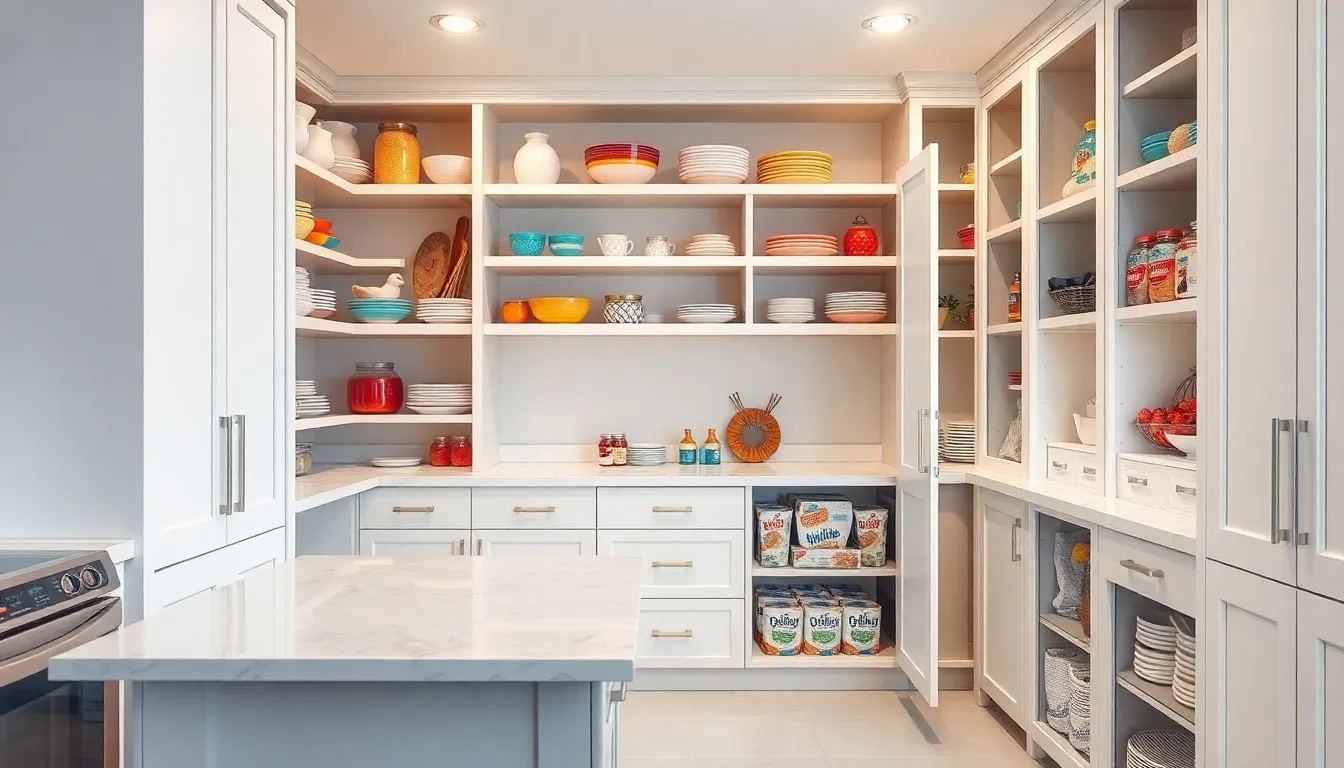
Choosing between open shelving and closed cabinet storage fundamentally impacts your pantry’s functionality and aesthetic appeal. Open shelving creates a cost-effective solution that’s easier to install and makes kitchens feel more spacious by allowing light to circulate freely. Closed cabinet storage provides a neat, organized appearance by hiding clutter and offers better protection for items that need shielding from dust and moisture.
When to Choose Open Pantry Shelving
Open pantry shelving works best when you want to showcase decorative dishes or frequently accessed cooking essentials. Small kitchens benefit tremendously from this approach since open shelves create visual spaciousness and eliminate the bulky appearance of traditional cabinetry. We recommend open shelving for displaying attractive spice collections, vintage containers, or colorful dishware that doubles as kitchen decor.
Accessibility becomes effortless with open shelving since you can quickly grab items without opening cabinet doors. Families with children find open shelving particularly useful for snacks and everyday items that kids need to reach independently. Installation simplicity makes open shelving an excellent choice for DIY enthusiasts who want professional results without complex carpentry skills.
Combining Open and Closed Storage Answers
Mixed storage approaches deliver the perfect balance between functionality and aesthetics in pantry design. We suggest displaying attractive items like matching glass containers or beautiful ceramics on open shelves while storing less appealing bulk goods behind closed doors. This combination allows you to maintain visual appeal while keeping sensitive or messy items protected.
Strategic placement of open and closed elements creates visual interest and practical zones within your pantry space. Upper shelves work excellently for closed storage of rarely used items, while eye-level open shelving showcases frequently accessed ingredients. Lower cabinets can house heavy appliances and cleaning supplies that you’d prefer to keep hidden from view.
Protecting Items From Dust and Moisture
Glass containers provide excellent protection for dry goods stored on open shelving while maintaining visual appeal and easy identification. Plastic storage containers offer lightweight alternatives that resist moisture and keep pantry staples fresh for extended periods. We recommend investing in airtight containers with secure lids to prevent contamination from airborne particles.
Positioning frequently used items on lower shelves minimizes dust accumulation since regular handling naturally keeps these areas cleaner. Closable bins and baskets work wonderfully for grouping smaller items together while providing protection from environmental factors. Strategic placement of items based on usage frequency ensures that your most sensitive ingredients stay protected while maintaining convenient access to daily essentials.
DIY Pantry Shelving Projects on a Budget
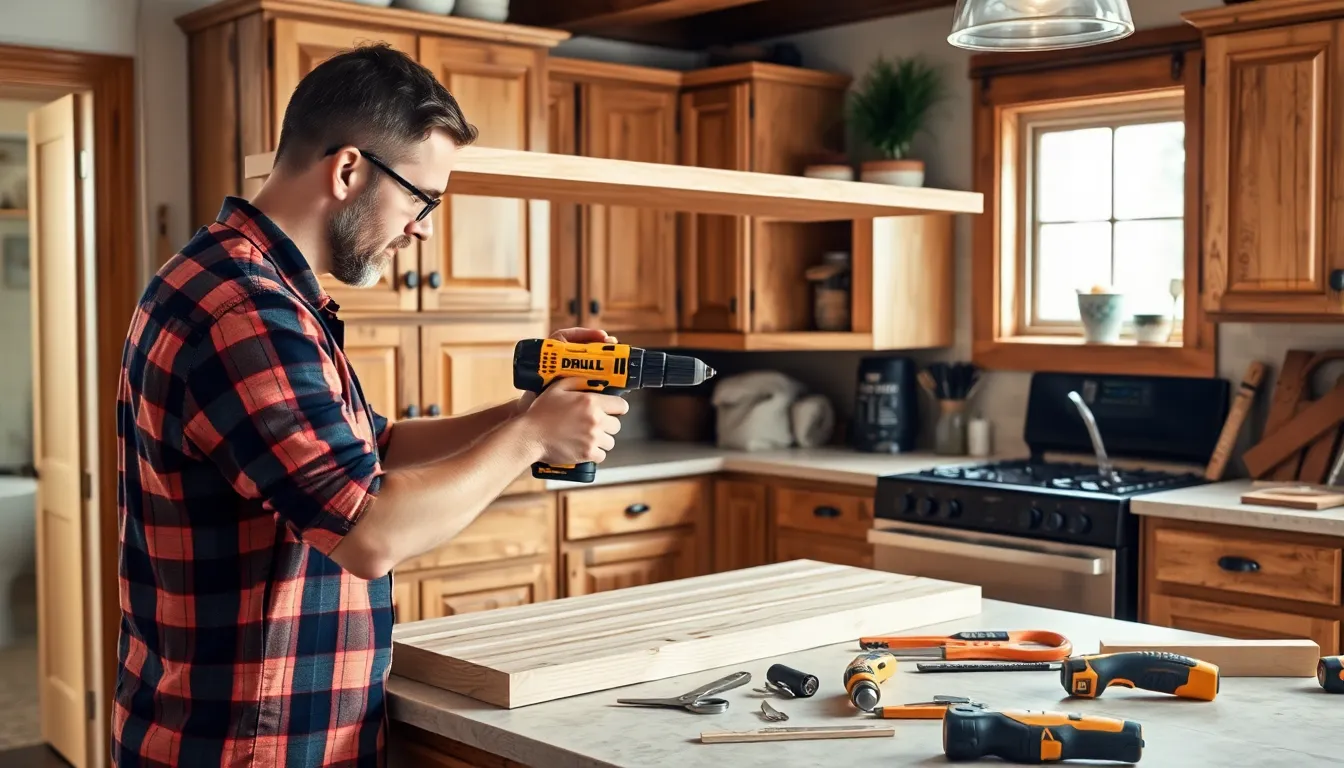
Budget-friendly pantry organization doesn’t require expensive custom installations. We can create professional-looking storage answers for under $50 using simple materials and basic woodworking skills.
Simple Wood Plank Shelf Ideas
Wooden plank shelves offer the most cost-effective approach to pantry storage, requiring only 2x4s cut to size and basic assembly techniques. We recommend starting with pine boards, which cost approximately 40% less than hardwood alternatives while providing adequate strength for most pantry items. Track shelving systems present another affordable option, allowing us to replace existing wire shelves with laminated wood surfaces that accommodate containers of varying sizes.
Floating shelves create a modern aesthetic using hidden brackets and wooden planks, maximizing vertical space without visible hardware. Installation requires locating wall studs and using appropriate fasteners to support up to 30 pounds per linear foot. Rustic plank installations work particularly well in farmhouse-style kitchens, where we can sand rough lumber to achieve desired texture and apply natural stain finishes.
Repurposing Materials for Custom Shelves
Reclaimed wood projects transform old pallets and shipping crates into unique pantry storage, reducing material costs by up to 70% compared to new lumber. We can disassemble pallets carefully to preserve usable boards, then sand and refinish them for food-safe storage applications. Furniture repurposing allows us to convert old bookshelves, entertainment centers, or cabinets into functional pantry units with minimal modifications.
Salvaged materials from construction sites or home renovations provide excellent sources for shelf brackets, support beams, and decorative elements. Thrift stores and garage sales often yield sturdy wooden pieces that we can transform with paint, stain, or hardware updates. Creative combinations of different reclaimed materials add character while keeping project costs under $30 per linear foot of shelving.
Essential Tools for DIY Pantry Projects
Power drills serve as the most important tool for pantry shelf construction, enabling precise screw hole placement and efficient assembly of brackets and supports. We recommend cordless models with adjustable torque settings to prevent over-driving screws in softer woods. Circular saws or miter saws provide clean, straight cuts essential for professional-looking results, though hand saws work adequately for smaller projects.
Measuring tools including tape measures and levels ensure accurate shelf placement and prevent costly mistakes during installation. Digital levels with audio alerts help us achieve perfectly horizontal shelves even in challenging spaces. Finishing supplies such as sandpaper, wood stain, and polyurethane protect our investment while creating food-safe surfaces that resist moisture and staining.
| Tool Category | Essential Items | Estimated Cost |
|---|---|---|
| Cutting Tools | Circular saw, miter box | $45-120 |
| Assembly Tools | Power drill, screwdriver bits | $35-80 |
| Measuring Tools | Tape measure, level | $15-30 |
| Finishing Supplies | Sandpaper, stain, brushes | $20-40 |
Professional Custom Shelving Installation
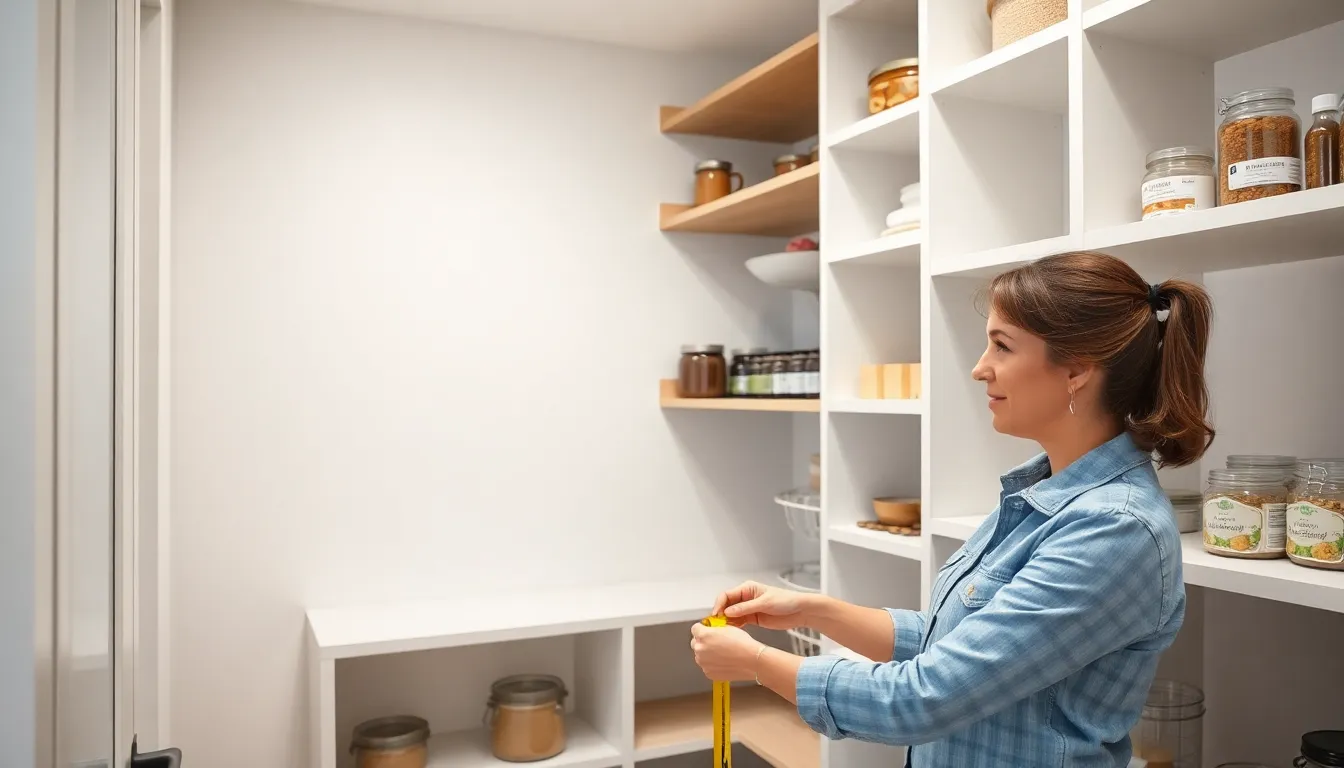
Professional installation becomes essential when you’re ready to transform your pantry with built-in storage answers that maximize every inch of available space. We’ve found that custom shelving systems offer the highest return on investment for serious pantry organization projects.
When to Hire a Professional Organizer
Complex pantry layouts require expert guidance to create truly functional storage systems. Professional organizers bring specialized knowledge about maximizing storage efficiency and can design answers that address your exact organizational challenges. They’ll assess your cooking habits, family size, and grocery storage patterns to create a personalized pantry system.
Storage space optimization becomes crucial when dealing with awkward corners, slanted ceilings, or irregular wall configurations. We recommend hiring professionals when your pantry has unique architectural features that require custom measurements and specialized installation techniques. Professional organizers can also coordinate with contractors to ensure your vision becomes reality without costly mistakes.
Cost Considerations for Custom Pantry Systems
Custom pantry installations range from $1,100 to $2,900 for complete systems, depending on materials and complexity. Shelving installation costs typically fall between $20.72 to $32.04 per linear foot, with site conditions and material choices affecting the final price.
Built-in shelving projects generally cost $205 to $473 per 25 linear feet, including both materials and professional labor. High-end materials like hardwood and premium finishes can increase costs significantly beyond these baseline estimates. We’ve observed that melamine systems offer excellent value while hardwood provides superior durability and aesthetic appeal.
Material selection impacts both upfront costs and long-term performance of your custom pantry system. Budget allocation should account for hardware, lighting integration, and specialized features like pull-out drawers or rotating mechanisms.
Working With Contractors for Built-In Answers
Contractor selection requires careful evaluation of experience with custom shelving installations and portfolio review of similar projects. We recommend requesting detailed proposals that include material specifications, timeline estimates, and warranty information for all work performed.
Design collaboration ensures your built-in answers align perfectly with your storage needs and aesthetic preferences. Contractors should provide 3D renderings or detailed drawings showing drawer placement, lighting integration, and finish selections before beginning installation work.
Communication throughout the project prevents costly misunderstandings and ensures quality results. Establish clear expectations about project timeline, cleanup responsibilities, and any potential complications that might arise during installation. Regular progress updates help maintain project momentum and address any concerns before they become major issues.
Quality assurance includes verifying proper wall anchoring, smooth drawer operation, and secure mounting of all shelving components. We suggest conducting a thorough inspection with your contractor before final payment to ensure all work meets agreed-upon specifications.
Conclusion
Creating an organized pantry doesn’t have to be overwhelming when you have the right shelving strategy. We’ve covered everything from budget-friendly DIY answers to professional custom installations that can transform any pantry into a functional storage powerhouse.
Whether you choose floating shelves for their modern appeal wire systems for maximum visibility or pull-out drawers for deep space access the key is selecting answers that match your exact needs and budget. Don’t forget about those corner spaces – they’re often the most underutilized areas in any pantry.
Remember that the best pantry shelving system is one you’ll actually use consistently. Start small with one or two shelving improvements and build from there. Your future self will thank you every time you step into your perfectly organized pantry.
Frequently Asked Questions
What are the main benefits of using floating shelves in a pantry?
Floating shelves create up to 30% more usable storage space compared to traditional units while providing a modern, minimalist look. They eliminate visual clutter and allow for customizable height adjustments based on your specific storage needs. The clean design maximizes vertical space efficiently.
How much can I save by choosing wire shelving over solid shelving?
Wire shelving systems are typically 40-60% less expensive than solid shelving options while maintaining excellent durability. They’re made from cold-drawn steel construction and offer superior visibility of stored items, making them a cost-effective choice for pantry organization.
What items are best stored on pull-out drawer shelves?
Pull-out drawer shelves are ideal for storing canned goods, spices, cooking oils, dry goods, and small appliances. They make items at the back of deep pantries easily accessible. Using clear bins within the drawers helps maintain organization and visibility.
Can I create effective pantry shelving on a tight budget?
Yes, professional-looking DIY pantry storage solutions can be created for under $50 using simple materials like pine boards and basic woodworking skills. Track shelving systems and repurposed materials from pallets or thrift stores offer additional budget-friendly options.
When should I consider hiring a professional for pantry shelving installation?
Professional installation is recommended for complex pantry layouts, custom built-in solutions, or when dealing with structural modifications. Custom pantry systems typically range from $1,100 to $2,900, but professionals ensure proper installation and can maximize your space efficiently.
How do corner shelving solutions maximize pantry space?
Corner shelving solutions like Lazy Susan rotating systems and triangular designs eliminate wasted space in overlooked corner areas. Dual-tier rotating systems can double storage capacity, while pull-out drawers and sliding baskets make corner items easily accessible.
What weight capacity should I consider for pantry shelving?
Weight capacity depends on your storage needs. Floating shelves vary by material – solid wood and metal brackets handle more weight than glass. For pull-out drawers storing heavy items, invest in heavy-duty slides. Always test weight capacity gradually during installation.
How do wire shelving systems prevent moisture buildup?
Wire shelving’s open design promotes natural airflow around stored items, preventing moisture buildup that can lead to spoilage. The ventilated construction allows air circulation while maintaining visibility of all stored products, making it ideal for pantry environments.

